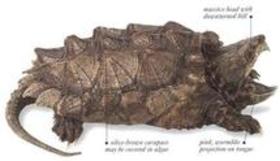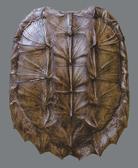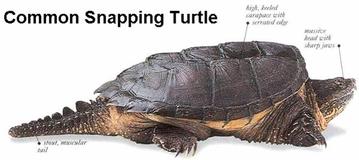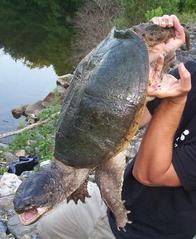TURTLE HUNTING ANYONE?
My dad taught me the fine art of Turtle Hunting. I'm referring to the common "Snapping Turtle". This prehistoric steadfast has an extremely bad temper and if given the opportunity can sever a finger or inflict a horribly bad wound with his vicious bite.If given the opportunity is very relative because your mere presence in his territory, is his, opportunity.
You can find "Ole Moss Back" in just about any State in the United States, and residing in any place that has year-round water such as a Pond, Tank, River, or Creek. Most of my hunting experiences have taken place in various Creeks.

The "Snapper" or common Snapping Turtle can reach weights up to forty (40) pounds, his head and neck can measure approximately two and a half (2½) inches around. He's all muscle and has a Hard Shell with Round Scallops on the Shell Edge directly behind his head, and has distinctive Sharp Serrated Points on the Shell Edge at the base of his Shell and where the Tail begins. He has Dinosaur Scallops that protrude upward on the top of the Tail and travel the length to its ending tip. His Breastplate is a yellow colored smooth plate with indentations that run horizontally and allows for flexibility. He is omnivorous but prefers meat and mainly feeds on such delicacies as Crayfish, Minnows, Adult Fish, various water insects and, has also been known to take a Duck or two. Yes, you read correctly, this "little Pretty" will swim quietly underneath the unsuspecting fowl and grab it by the feet pulling it under, for its dinner.
Okay, if we are going hunting for Turtle, then we must dress the part. you'll need a Cap, Long Sleeve Shirt with a button down collar, a pair of Levis, Lee Riders, Dungarees, or other old Denims, a pair of old smelly Socks, not necessarily matched, and a pair of "Tennies", not necessarily matched.
Next comes the hunting implements, which calls for an old Broom Handle, Mop Handle, Hoe Handle, or any like item, just as long as it's straight, long, and comfortable to the feel.Finally, we need a "Tow Sack" or "Gunny Sack", (Burlap Bag) with a long and heavy gage Tie Rope or String.
We then have to select a likely hunting spot, so we'll look for a Creek that we know has water in it year-round, full of lots and lots of Snags, smelly standing water, brim full of Mosquito Larvae, and Adult Mosquitoes that delight in sucking out your blood while you are sweating profusely under a hot beating Sun in ninety (90) to one hundred plus (100+) degree temperature. Be sure there is plenty of Cut Grass, Nestles, Thorny Limbs, and the like to cut your body into little pieces each time you get out of the Creek Bed to relocate.Sprinkle that with lots of Cow, Sheep, and Horse Dung to walk through, and as if that isn't enough be sure the odor of the slimy Algae accumulations is sufficient to turn the nose of a Skunk. If all of these conditions are met, then "by golly" we're in the right place to match wits with "Ole Moss Back".

On with the hunt. Once we've climbed over all the Barbed Wire Fences and lowered ourselves into the Creek, go to any Creek Bank and begin to prod and poke your Broom Handle, or like device in and around the Bank, around various Snags, all through the Creek Bed while listening intently for a "hollow" sound. Upon hearing the telltale sound, immediately and without hesitation place your foot directly on top of the item that produced the sound. Run your Stick around the item feeling for a "hit," "bump," or "movement" from below.If you feel a hit, or bump on the Stick or if something begins to move under your foot, then you can be pretty certain that you have found your quarry.
If you are standing in chest deep water, take a deep breath and stick your head under water, place your hand on the leg that is pressing down on the Turtle, and run it down to your foot, being very careful to keep your hand on your leg. Feel for the Turtle's Shell and inch ever so slowly toward the Shell Edge. If you know where the bump or hit came from, go to the opposite direction. This should be its Tail End. Feel for the jagged or Pointed Serrations to confirm that it is his Tail End. Once confirmed, then reach in the directions that the Serrations point until you find the base of its Tail. Usually the Turtle will bend its Tail inward under its body. You will have to pull its tail away from the Shell in order be able to get a firm hold. After you have a firm grip on the base of the Tail, remove your foot and pull up and away from your body being sure to position the Turtle's Breastplate facing toward your body. This will position his head and open gaping, hissing, pink mouth away from you, and make it more difficult for him to bite.
 Placing your catch into the "Gunny Sack" can be a little tricky.Do this on the Creek Bank, so if you lose your grip, you won't lose your Turtle back into the Creek. Place the Sack on the ground, and open the end with your Stick. Point the Turtle toward the Sack opening and shove his head and body into the Sack. Pull the Sack up and away from your body thus depositing "Mr Turtle" at the bottom of your Sack. Tie the Sack opening off, being sure everything is secure. Tie the remaining Rope or Line to your Belt, pick the Sack up, jump back into the Creek, throw the Sack behind you, and continue the hunt. The object here is to allow the Turtle and Sack to be pulled along with you in the Creek thus eliminating having to carry twenty five (25) to forty (40) pounds of Turtle around.
Placing your catch into the "Gunny Sack" can be a little tricky.Do this on the Creek Bank, so if you lose your grip, you won't lose your Turtle back into the Creek. Place the Sack on the ground, and open the end with your Stick. Point the Turtle toward the Sack opening and shove his head and body into the Sack. Pull the Sack up and away from your body thus depositing "Mr Turtle" at the bottom of your Sack. Tie the Sack opening off, being sure everything is secure. Tie the remaining Rope or Line to your Belt, pick the Sack up, jump back into the Creek, throw the Sack behind you, and continue the hunt. The object here is to allow the Turtle and Sack to be pulled along with you in the Creek thus eliminating having to carry twenty five (25) to forty (40) pounds of Turtle around.If you are lucky throughout the remainder of your hunt, you may collect several more Turtles, but don't take more than you plan to eat. Yes, I said eat! Turtle is quite a delicacy and has been Said to contain seven (7) different flavors of meat. I can attest that you will taste several different flavors, but I would be hard pressed to specifically identify those flavors.
Once you have collected your Turtles, the next step is the cleaning process. Ah yes, fun time is about to begin. Let me tell you here and now, that this is a task for not one, but two men. No boys, or women, should attempt this process.(I'm sure there are some boys and women out there who could accomplish this task, but for the most part it shouldn't be attempted by either) While I don't want to offend anyone's sensibilities I'll just say here, that the "Snapper" is a very strong and durable beast. It takes a lot of strength to skin a Turtle, so someone must hold the Shell while the other party does the deed. Any further description here would be overkill. (No pun intended)
For cooking instructions, may I suggest Justin Wilson's "Cajun Cookbook", or you can scan the Libraries efficient "Dewey Decimal System" under "Exotic" food preparations.
1996
Return to Index